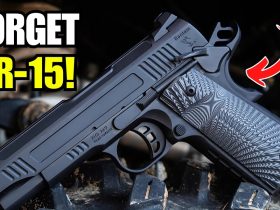Caracal’s CMP9 pistol is a close descendant of the selective-fire submachine gun launched in 2022 as a replacement for the United Arab Emirates’ aging stock of Heckler & Koch MP5s. Two versions of the CMP9 are now available that differ with respect to handguard and barrel length. The shorter “K” variant is the subject of this review.
The CMP9K is a blowback-operated, semi-automatic chambered in 9mm. At 14 inches long and weighing 72 ounces unloaded, it’s slightly longer than the 13.8-inch H&K SP5K-PDW and nearly 5 ounces heavier. It is constructed with upper and lower receivers milled from 7075 T6 aluminum forgings and joined with a captive push pin at the front and rear. Feeding is from MP5-type magazines, with two, 30-round curved mags included. The test pistol was made in the UAE, but manufacturing will eventually migrate to the Caracal USA facility in Lewiston, ID.
The CMP9K uses a conventional AR-15 trigger/hammer group with a slightly shortened hammer tail. Its controls have similar locations and functions as those found on the AR-15, including a non-reciprocating, ambidextrous charging handle and a bilateral safety and magazine release. Because an MP5 magazine is used, however, the action will not lock open automatically after the last round is fired, but it can be locked open manually using the bilateral bolt-catch/release.
This pistol is modular and configurable. Its upper receiver and handguard are easily changed without tools, and the barrel is secured by a single setscrew. Though this modularity will be more relevant in 2026 when Caracal expects to sell different stocks, barrels and upper-receiver assemblies—including an integrally suppressed version—replacing a damaged barrel with ease is always valued; just ask anyone struggling with the pinned and pressed-in barrel on the H&K SP5. The lower receiver has a rail to mount an arm brace, sling or (after receiving ATF approval to make a short-barreled rifle) a shoulder stock.
At the rear of the Caracal CMP9K is a short section of Picatinny rail where a brace or sling can be attached • Those familiar with AR-pattern firearms will be at home with the fire controls of the CMP9K • The charging handle is generously sized yet unobtrusive • M-Lok attachment slots grace the fore-end at the 3-, 6- and 9-o’clock positions, should lights, lasers or other accessories be desired • A small compartment in the grip offers a convenient means for storing tools or batteries • Ambidextrous controls make the pistol easy to use for both righties and lefties and are depicted in the standard pictogram format on both sides of the receiver • An AR-compatible grip offers comfort and adaptability.
Above, the handguard is constructed from 6061 T6 aluminum alloy, and the 6-inch, cold-hammer-forged barrel is made from 32 CMV steel. Sights can be mounted on the receiver’s full-length, 1913-style rail.
Finishes include Type 3 hardcoat anodizing on the receivers and handguard, plasma nitride on the barrel and magnesium phosphate on the controls and lower internals. Tightly fitted receivers and parts denote skilled workmanship and close-tolerance machining, and there were no visible machine-tool marks except for a few on the underside of the bolt.
The CMP9K shares much of the parent submachine gun’s mil-spec design and testing, implying a high level of reliability, durability and longevity. Caracal engineers used NATO-spec ammo to validate that both the submachine gun and the CMP9K met NATO performance standards for endurance, with bore obstructions and in adverse conditions including high/low temperatures, mud, sand, salt, fog, etc. Each assembled barrel and bolt is tested at a C.I.P. proof house with overpressure loads to ensure strength and function tested with NATO loads.
The pistol has several noteworthy design features. A capture lever augments the typically used retention spring to prevent the firing pin from contacting the primer as the bolt slams forward against the breechface. A steel bridge in the lower receiver prevents the hammer from moving backward too far and damaging the disconnector, and a hardened locking pin retains the firing-pin assembly in the bolt instead of an easily bent cotter pin. The flash suppressor has 12 intricately made flutes intended to maximize flash dispersion during night fire compared with the ubiquitous six-flute type. Finally, the only non-metallic parts are the polymer grip and a rubber buffer, which dampens recoil and protects the lower receiver.
During the 200-round test, there were two failures to eject Remington shell cases during the first 20 shots, which I attribute to either break in or an underpowered practice load. There’s very little muzzle rise, and a full magazine can be easily inserted with the bolt closed should a tactical reload be required—something the H&K SP5 is not designed to do.

Ergonomics are very good for left- or right-handed shooters, but a trigger with a lighter pull weight than 6.3 pounds and a beveled magazine well to speed reloading would make a good gun like the CMP9K even better. The AR-style trigger/hammer group can be switched with minor modification of the hammer tail depending on the maker, but the CMP9K isn’t a competition piece where those refinements, along with last-round, bolt-hold-open capability, are a much-needed necessity.
While far from unique, the CMP9K is well-made, durable and capably fills its intended role as a modular defensive handgun that should far outlast many of its competitors in the current crop of large-format semi-automatic pistols.


Read the full article here

















Leave a Reply